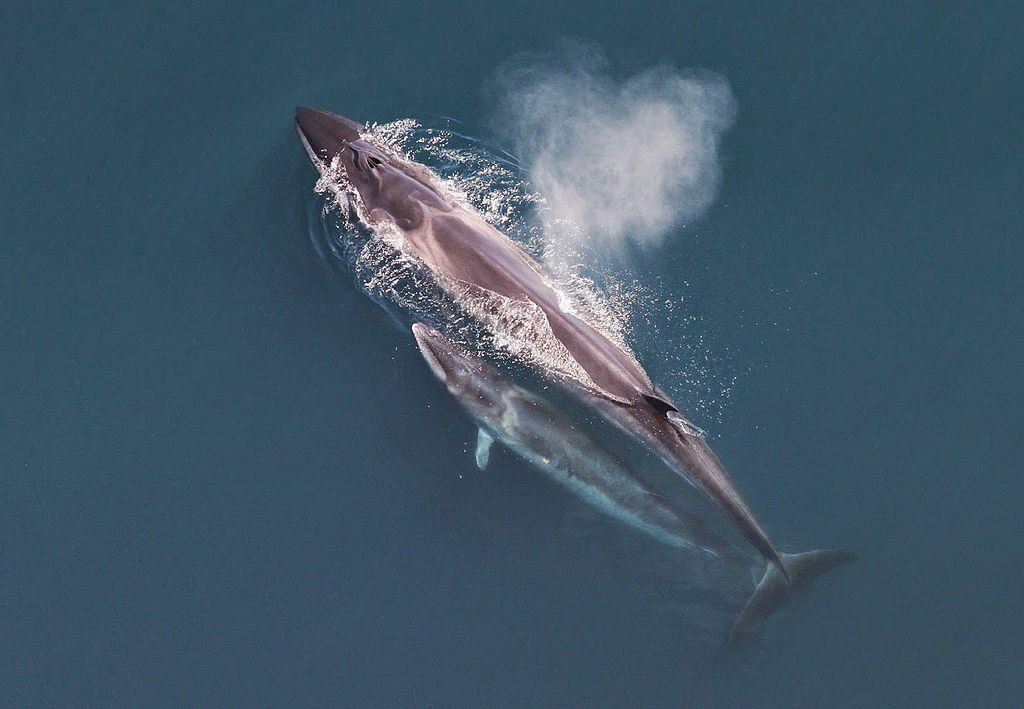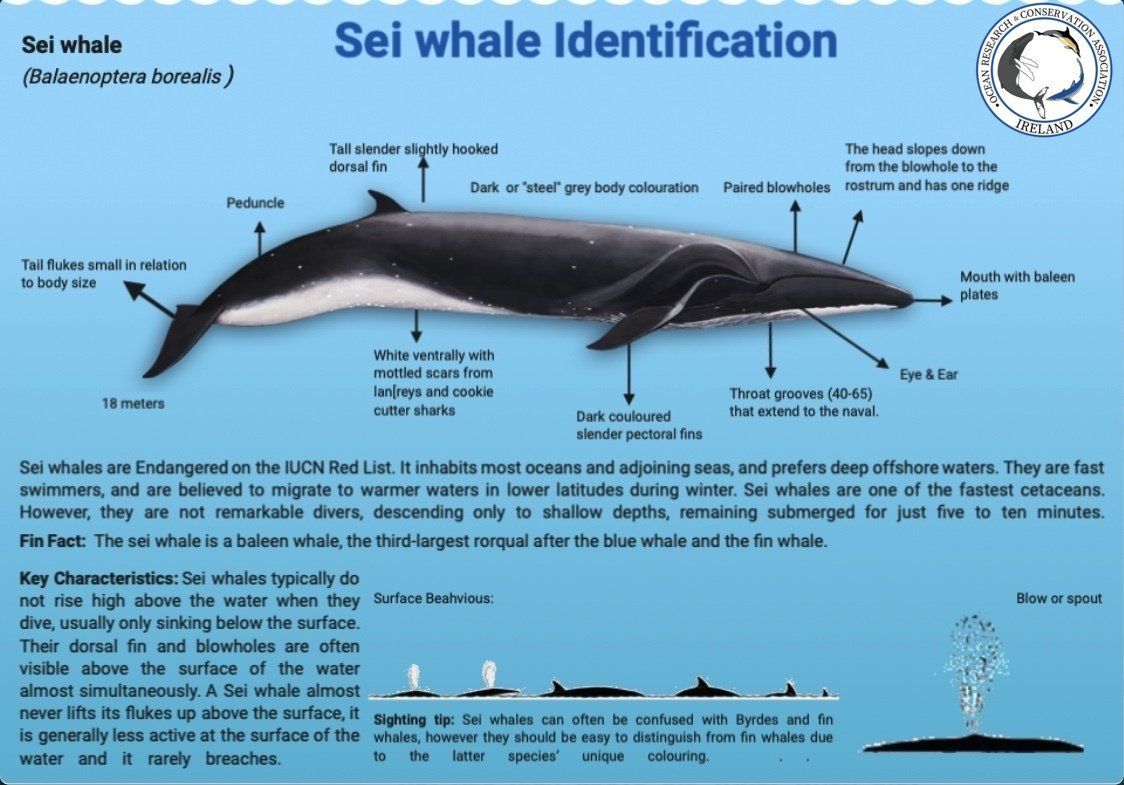Sei Whale (Balaenoptera borealis)
Sei whale (Balaenoptera borealis) mother and calf as seen from the air. Source: NOAA
Next Species ---->
<----- Previous Species
Classification:
Kingdom:
Animalia
Phylum:
Chordata
Class:
Mammalia
Order:
Artiodactyla
Infraorder:
Cetacea
Family:
Balaenopteridae
Genus:
Balaenoptera
Species:
B.
borealis
Get the Facts:
The sei whale is a baleen whale and is the third largest rorqual after the blue whale and the fin whale. The sei whale's scientific name borealis, translates from Latin to English meaning northern. In the Pacific ocean the sei whale has been called the Japan finner. "Finner" is a common term used to refer to rorquals.
Species Identification:
The sei whale is slim and streamlined but more bulky than the fin whale. Its back and sides are a dark grey colour, while the belly and ventral grooves are greyish-white. Some sei whales have a white or light coloured area to the flippers (pectoral fins), and a white streak might be seen extending to and behind the ear. The flipper and flukes are dark grey or bluish dorsally and ventrally the body often has a galvanised appearance due to light coloured scars inflicted by various types of parasitic organisms. The jaw and mouth are generally uniformly grey. The head is 1/5 or 1/4 of the total body length and increases relative to body size with age. The head is less pointed than that of a fin whale and less rounded than that of a blue whale and is curved downward. One prominent ridge extends from the blowhole to the tip of the rostrum and is a distinguishing characteristic. They have a large falcate and curved dorsal fin. The dorsal fin is located about one-third of the body length. Sei whales have less and relatively shorter throat grooves than blue, fin or minke whales., from 40 to 65, and these reach down to midway between the flippers and the naval. Sei whales have between 300 - 400 baleen plates measuring between 78-80 cm. They also have a relatively bushy blow in comparison to a fin whale which can reach 3 meters in length.
Similar species: fin whale and Bryde's whale.
Diet:
The sei whale feeds primarily on surface plankton; including copepods and euphausiids and its specific prey type varies depending on temperature and latitude. The most common prey type in the Northern Hemisphere include Calanus copepod species and in the Southern Hemisphere, close to Antarctic convergences, these are replaced by euphausiids, amphipods, and Euphausiia closer to polar regions.
Habitat:
Sei whale are a cosmopolitan species, with a patchy oceanic distribution. The prefer temperate deep offshore waters more than any other baleen whale species. In summer, they do not move as far north towards the poles as other species and do not usually enter icy waters. Their wintering grounds in the open oceans are still unknown. In the East Atlantic, they are thought to winter off Spain, Portugal and north-west Africa and move towards northern waters off Norway, Shetland, Orkney and the Faroes. There has been few sightings in Irish waters, mainly off the west coast in Co. Mayo. Strandings of sei whale have been recorded off the north coast of Ireland.
Behaviour:
The sei whale is thought to be one of the fastest swimming cetaceans, similar to the fin whale. When a sei whale dives, it usually submerges by sinking quietly beneath the surface, often remaining only a few meters deep, leaving a "footprint" or a series of swirls or tracks as it moves its flukes. Sei whales rarely lift their tail flukes when they dive, similar to minke whales. They often swim horizontally near the waters surface when feeding (skim feeding), in contrast to blue, fin and humpback whales which may turn on their side to feed. Sei whales may surface regularly when feeding with blows at 20 - 30 second intervals followed by a dive for 15 minutes or more. When say whales surface they do so at a shallow angle and the blow hole, dorsal fin and most of the back becomes visible simultaneously and remain seen for relatively long periods of time.
Social Structure:
Sei whales are generally observed alone or in groups of 2-5 individuals, although larger aggregations have been seen on feeding grounds. Similar to other baleen whale species, sei whales may show sexual segregation in the population during migration.
Reproduction:
Sei whales in the Northern Hemisphere mate between November and February, in comparison, mating in the Southern Hemisphere occurs between May and July. Gestation occurs for a period of 10.5 to 12 months. Females give birth to a single calf measuring 450 cm in length. Males reach sexual maturity at about 12.2 meters length and females at around 13.1 meters at the age of 10 years old.
Lifespan:
Maturity is typically reached between 7- 11 years and the average lifespan is 50 - 70 years.
Sei whales of the World:
Two sei whale subspecies have been identified - the northern sei whale (B.b. borealis) and the Southern sei whale (B.b.schlegelii).
Map Source: International Whaling Commission (IWC).
Population Status:
Globally there are estimated to be 50,000 sei whales. Sei whales are listed as Endangered
on the IUCN Red List.
Conservation Threats:
Threats to sei whales include over-fishing and prey depletion, entanglement in fishing gear, ship strike, and noise pollution.






